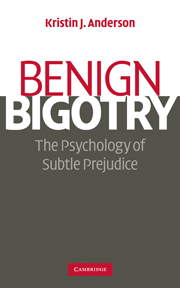Book contents
- Frontmatter
- Contents
- Acknowledgments
- Introduction: The changing place of prejudice: a migration underground
- 1 “Those people all look alike”: The myth of the other
- 2 “They must be guilty of something”: Myths of criminalization
- 3 “Feminists are man-haters”: Backlash myth-making
- 4 “Gays flaunt their sexuality”: The myth of hypersexuality
- 5 “I'm not a racist, I'm colorblind”: The myth of neutrality
- 6 “Affirmative action is reverse racism”: The myth of merit
- Conclusion
- Index
Introduction: The changing place of prejudice: a migration underground
Published online by Cambridge University Press: 05 June 2012
- Frontmatter
- Contents
- Acknowledgments
- Introduction: The changing place of prejudice: a migration underground
- 1 “Those people all look alike”: The myth of the other
- 2 “They must be guilty of something”: Myths of criminalization
- 3 “Feminists are man-haters”: Backlash myth-making
- 4 “Gays flaunt their sexuality”: The myth of hypersexuality
- 5 “I'm not a racist, I'm colorblind”: The myth of neutrality
- 6 “Affirmative action is reverse racism”: The myth of merit
- Conclusion
- Index
Summary
The secret life of subtle prejudice
You used to be able to spot them a mile away. Bigots. If they weren't wearing white hoods, you could count on their willingness to identify themselves in conversation by their unabashed use of racial epithets and sexist stereotypes. They were the co-workers telling homophobic jokes in the break room. They were the people who insisted that a woman could never be president because her pre-menstrual syndrome might one day lead to nuclear war. Bigots – loud and proud and easy to recognize from their behavior and conversation. The bigot was able to find justification and comfort in a deeply rooted set of ideas supported by prejudice at cultural and institutional levels.
Regardless of the precise stereotypes, people of color, women, poor people, and sexual minorities have historically been represented as genetically inferior. Since the 1950s, academics, activists, and policymakers have made serious efforts to focus on social and political conditions, and to challenge the very concept of a biological basis of “race.” The sixties and seventies saw massive social movements advocating civil rights, feminism, and gay liberation. There have been distinctive shifts that indicate a greater willingness to understand the shaping role of environmental factors, to explore differences without always assuming deficits, and at least to pretend to value egalitarianism and equal opportunity.
- Type
- Chapter
- Information
- Benign BigotryThe Psychology of Subtle Prejudice, pp. 1 - 21Publisher: Cambridge University PressPrint publication year: 2009



